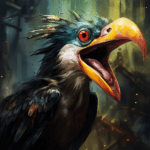Exploring the Toothless Wonders of the Avian World

Birds have long fascinated humans with their diverse forms, behaviors, and adaptations. One question that often piques curiosity is whether birds possess teeth. While the majority of bird species are indeed toothless, the answer to this question isn’t as straightforward as it might seem. In this article, we delve into the fascinating world of avian dentition, exploring the reasons behind their toothless nature, the exceptions that prove the rule, and the unique adaptations that have evolved to replace conventional teeth.
The Toothless Norm
Birds, in general, lack teeth in the traditional sense that mammals possess them. Instead of teeth rooted in their jawbones, birds have evolved a specialized beak structure designed for various functions, including feeding, grooming, and even defense. This adaptation has allowed birds to fill ecological niches that would otherwise be unavailable to them.
Ancient Avian Teeth
While most modern birds don’t possess teeth, some of their distant ancestors did. Fossil evidence reveals that many early birds and their close relatives sported teeth. This intriguing historical aspect of avian evolution offers a glimpse into the transition from toothed to toothless forms, shedding light on the processes that shaped the avian lineage.
Tooth-Like Adaptations
Although lacking true teeth, some bird species have developed adaptations that serve similar functions. The raptor group, including eagles, hawks, and owls, boasts sharp, hooked beaks that aid in tearing prey apart. Similarly, birds like pigeons and doves possess a unique adaptation known as a “gizzard” that helps break down tough food items they consume.
Toothed Exceptions
While the majority of birds remain without teeth, there are fascinating exceptions. One notable example is the South American horned screamer, which has bony extensions in its mouth resembling teeth. These structures aid in capturing and consuming aquatic plants. Another exception is the extinct giant predatory bird known as the Pelagornis, which had a toothed beak capable of catching fish and squid.
The Evolutionary Story
The loss of teeth in birds is thought to be an adaptation driven by factors such as weight reduction for flight, the development of beaks for specialized diets, and the efficiency of a gizzard-based digestive system. Understanding the evolutionary path that led to modern avian dentition provides insights into the ways species adapt to their changing environments.
As we marvel at the breathtaking variety of birds around us, the absence of teeth in most of them serves as a testament to the remarkable diversity of adaptations that nature can produce. Whether they rely on beaks, gizzards, or other specialized structures, birds continue to capture our imagination and remind us of the intricate tapestry of life on Earth.
BirdTeethMyth #AvianAdaptations #ToothlessWonders #BirdBeaks #EvolutionOfDentition

